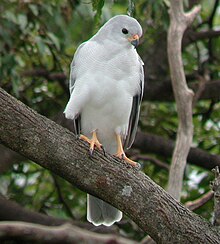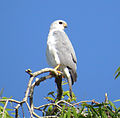Grey goshawk
| Grey goshawk | |
|---|---|

| |
| Scientific classification | |
| Domain: | Eukaryota |
| Kingdom: | Animalia |
| Phylum: | Chordata |
| Class: | Aves |
| Order: | Accipitriformes |
| Family: | Accipitridae |
| Genus: | Accipiter |
| Species: | A. novaehollandiae
|
| Binomial name | |
| Accipiter novaehollandiae (Gmelin, JF, 1788)
| |

The grey goshawk (Accipiter novaehollandiae) is a strongly built, medium-sized bird of prey in the family Accipitridae that is found in eastern and northern Australia. The white morph of this species is known as the white goshawk.
Taxonomy
The grey goshawk was
Description
The grey morph has a pale grey head and back, dark wingtips, barred grey breast and tail, and white underparts. The white morph is the only bird of prey in the world to be entirely white.[citation needed]
Grey goshawks are the largest
Distribution and habitat
The grey goshawk is found along the coasts of northern, eastern and south-eastern Australia, Tasmania and rarely Western Australia. The variable goshawk was previously considered a subspecies.
Their preferred habitats are forests, tall woodlands, and timbered watercourses.
Behaviour and ecology
Food and feeding
Grey goshawks often seem to vary their prey selection opportunistically. For an Accipiter, they relatively often select
Hunting is often done by stealth, but grey goshawks are willing to pursue their prey before catching it with their
Breeding
Grey and white goshawks interbreed freely. They partner for life, breeding from July to December. They nest in tall trees on a platform of sticks and twigs with a central depression lined with green leaves. The female lays a clutch containing 2 or 3 eggs, which are
The female is usually responsible for incubating the eggs and feeding the young. The male does most of the hunting.[12]
Conservation status
State of Tasmania
- This species is "endangered" in Tasmania.[13]
State of Victoria (Australia)
- The grey goshawk is listed as "threatened" on the Victorian Flora and Fauna Guarantee Act 1988.[14] Under this Act, an "Action Statement" for the recovery and future management of this species has not been prepared.[15]
- On the 2007 advisory list of threatened vertebrate fauna in Victoria, this species is listed as vulnerable.[16]
State of Queensland
- This species is listed as "least concern" in Queensland.[17]
Gallery
References
- . Retrieved 11 November 2021.
- ^ Gmelin, Johann Friedrich (1788). Systema naturae per regna tria naturae : secundum classes, ordines, genera, species, cum characteribus, differentiis, synonymis, locis (in Latin). Vol. 1, Part 1 (13th ed.). Lipsiae [Leipzig]: Georg. Emanuel. Beer. p. 264.
- ^ Latham, John (1785). A General Synopsis of Birds. Vol. 3, Part 1. London: Printed for Leigh and Sotheby. p. 435.
- JSTOR 4080770.
- ^ Brisson, Mathurin Jacques (1760). Ornithologie; ou, Méthode contenant la division des oiseaux en ordres, sections, genres, espéces & leurs variétés (in French). Vol. 1. Paris: Jean-Baptiste Bauche. pp. 28, 310.
- ^ Rasmussen, Pamela, eds. (August 2022). "Hoatzin, New World vultures, Secretarybird, raptors". IOC World Bird List Version 12.2. International Ornithologists' Union. Retrieved 5 December 2022.
- ISBN 978-1-4081-2501-4.
- ^ ISBN 0-618-12762-3.
- ^ ISBN 978-1-4200-6444-5.
- ^ Olsen, P. D., Debus, S. J. S., Czechura, G. V., & Mooney, N. J. (2016). Comparative feeding ecology of the grey goshawk Accipiter novaehollandiae and brown goshawk Accipiter fasciatus. Australian Field Ornithology, 13(6).
- ^ Cupper, J., & Cupper, L. (1981). Hawks in focus: A study of Australia's birds of prey. Harrell Books.
- ^ "Birds in Backyards - Grey Goshawk". Archived from the original on 2007-12-14. Retrieved 2007-04-14.
- ^ https://www.threatenedspecieslink.tas.gov.au/Pages/Grey-Goshawk.aspx
- ^ https://web.archive.org/web/20050718182613/http://www.dse.vic.gov.au/DSE/nrenpa.nsf/LinkView/EADA0F1874AF9CF24A2567C1001020A388BBA5581CF9D859CA256BB300271BDB
- ^ https://web.archive.org/web/20060911130015/http://www.dse.vic.gov.au/DSE/nrenpa.nsf/LinkView/617768308BCB666E4A25684E00192281E7A24BB36FF60A144A256DEA00244294
- ISBN 978-1-74208-039-0.
- ^ "Species profile—Accipiter novaehollandiae (grey goshawk)". Environment, land and water - Queensland Government. Queensland Government. Retrieved 28 December 2020.
- Marchant, S.; & Higgins, P.J. (Eds). (1993). ISBN 0-19-553069-1



